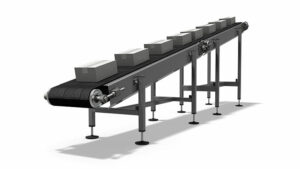The wing pulley is main component of the conveyor belt material handling.
It is known as self cleaning pulley. It is installed at tail of system to provide non continuous contact of particular wings.
The types of wing pulleys are differentiated by component thickness and applications.
- Heavy-duty pulley
- Mine duty pulley
- Spiral wing pulley
- EZ mount wing pulley
- Beater bar wing pulley
- SSP- Static shaft pulley
- Quarry duty pulley
- Grain herringbone pulley
There is a wide range of applications of the wing pulley. The classification s given based on its applications like mine, quarry, etc. The pulley is a primary component of the conveyor. The conveyor is widely used in the material handling system. The bulk material can be transferred with the conveyor easily.

The use of a this pulley can increase the life of the belt conveyor—the excessive build of the material on the belt in the regular drum pulley.
These phenomena cause damage to the belt conveyor and affect its performance. The wing pulleys are generally mounted on the tail side of the conveyor belt. The primary purpose of this system is to increase the belt life.
The location of this pulley is at the tail side of the conveyor belt. This pulley is also known as the self-cleaning pulley. The wing-type construction of the pulley lets the material distributed on the wings. There are fewer chances of material build up, so the flow of material is continuous.
Applications of wing pulley
The wing pulley can be used in a variety of material handling industries.
- Coal
- Grain
- Agriculture material movement
- Sand and flour handing
- Tobacco manufacturing industries
- Mineral handling system
- Metal handling
The use of a wing can increase the performance of the belt conveyor with smooth running.
What is a wing pulley
This type of pulley is the mainly used at tail side of the conveyor belt.
It is called as a self-cleaning pulley due to its features. It is providing non-continuous contact of particular wings.
This construction design helps to make loose material collected far from the contact area. If we have a requirement of continuous contact, we should use a spiral pulley to complete fill contact. This pulley’s dimensions can be differentiated by using the thickness of the component and the rain force agent.
If the component thickness is more, the heavier wing pulley is needed in the conveyor. The rain force ring and the gussets are used between wing and member to sustain the heavier load. The pulley capacity depends on the diameter of the pulley.
Spiral wing pulley
The spiral pulley is functional when continuous surface contact is desired.
It is constructed by the pair of bars that are helically wound with the convolution of the individual.
The double cone design is constructed by attaching the gussets with every wing. The self-cleaning action is being done with the rotary motion of the spiral pulley. The different material is thrown toward the side of the conveyor belt.
The spiral pulley is helpful to reduce belt misalignment. There are fewer chances f the material being stuck between the belt and pulley due to many wings in the pulley.
Suppose steel bars are wound on the drum pulley, which meets at a center. The drum pulley is turned into a spiral pulley—the spiral pulley, also known as a pulley which provides continuous contact with the belt. The spiral flutes are found at both ends of the pulley.
Wing pulley dimensions
The dimensions of the this pulley depend on the size of the system
The main three dimensions of the pulley are pulley diameter, shaft diameter, and face width.
These dimensions can be calculated by the design of the pulley with known values of parameters. The size of the pulley depends on the size of the conveyor and its applications.
Mine duty wing pulley
There are some pulleys designed for the heavier applications like mine
The construction is heavier that reducing the chances of excessive material growth. The self-clean action is more effective in reducing mental fatigue.
This kind of pulley is best suited for rough applications where the conditions are abrasive.
The mine duty or heavy-duty is designed for heavy loading applications. The pulley faces bulk handing with more material removal. A variety of different hub styles and gussets are available. We can choose the proper combination for desired applications.
Wing pulley lagging
There are some lagging provided on the pulley used in conveyor material handling.
It is a material layer provided over a pulley to protect the pulley, maintain friction between the belt and pulley and let the water take off from a pulley
The lagging material is designed to obtain maximum traction force in both directions. There are some more benefits of the pulley lagging discussed as below,
- Reduction in downtime
- Maintenance cost reduction
- It is easy to adjust with flat and crown pulley
- Decrease in wear between belt and pulley
- Spillage prevention
- Replacement can be possible without detaching the pulley
Wing pulley design
Various parameter calculations can design the wing pulley.
The pulley can be designed by calculating pulley diameter, shaft diameter, and face width.
The dimension of the wing pulley can be obtained by knowing the following parameters of the pulley :
- Width of the belt
- Centre of bearings
- Tension on the tight side of the belt
- Tension on the slack side of the belt
- Arc of contact between belt.
- If the width of the belt is less than 42 Inches,
- the face width of pulley = Width of the belt + 2
- If the width of the belt is more than 42 inches,
- the face width of pulley = Width of the belt + 3
Wing pulley VS snub pulley
The applications of both pulleys are different, as discussed below,
The wing pulley is a self-cleaning pulley and located at the head and tail of the conveyor. The snub pulley is situated near to drive at return.
The function of the wing pulley is to drive the conveyor belt, whereas the role of the snub pulley is to raise the angle of contact on the drive pulley.
The dimensions of the wing pulley are more significant than the dimensions of the snub pulley.

I am Deepak Kumar Jani, Pursuing PhD in Mechanical- Renewable energy. I have five years of teaching and two-year research experience. My subject area of interest are thermal engineering, automobile engineering, Mechanical measurement, Engineering Drawing, Fluid mechanics etc. I have filed a patent on “Hybridization of green energy for power production”. I have published 17 research papers and two books.
I am glad to be part of Lambdageeks and would like to present some of my expertise in a simplistic way with the readers.
Apart from academics and research, I like wandering in nature, capturing nature and creating awareness about nature among people.
Also refer my You-tube Channel regarding “Invitation from Nature”